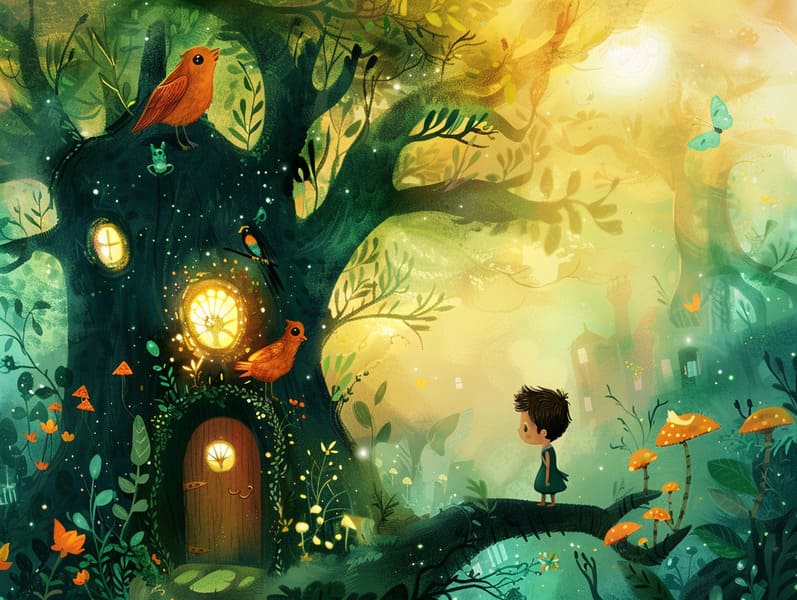
Legendary fairy tales have ancient roots. These tales have been recounted from one generation to the next millennia before they were ever written down. They came from a variety of cultures, including Middle Eastern traditions. They were initially conveyed among grown-ups, often carrying themes and messages aligned with the societal norms and beliefs of the time.
The Grimm brothers, Jacob and Wilhelm Grimm, were among the first to assemble many of these beloved fairy tales. Their compilation, "Grimm's Fairy Tales," included classics like "Cinder Maid," "Hansel and Gretel," and "Little Snow White," which have since become mainstays in the world of timeless fairy tales. Similarly, H. C. Andersen's enchanting fairy tales, such as "The Mermaid," and "The Duckling that Could," have gained the love worldwide, guaranteeing their place in the pantheon of famous fairy tales.
Though they are old, these tales remain as significant as ever, especially as nighttime stories for kids. These whimsical stories are now available in diverse formats, including richly illustrated books, fantastical animations, and web-based fairy tales.
Their lasting presence can be traced to several whimsical characteristics:
Moral Lessons: Ancient fairy tales often offer important moral lessons. Fairy tales like "The Tale of the Boy Who Cried Wolf" teach the virtue of being truthful, while "The Tale of the Tortoise and the Hare" exemplify the merits of tenacity and humility. These narratives offer kids clear distinctions between moral and immoral, building their moral compass in a mild yet important way.
Sympathy and Perception: Old fairy tales frequently involve heroes facing challenges and struggles, inciting young listeners to resonate with their struggles and back their triumphs. For instance, "Beauty's Beast" highlights the merit of seeing beyond the surface to understand the inner core of a soul, promoting understanding and recognition.
Cultural Recognition: Many traditional fairy tales are imbued with the cultural contexts from which they developed. Immersing in these stories can provide captivating looks into different societies, encouraging a sense of international awareness and discernment.
Inventiveness and Imagination: The mythical elements in ancient fairy tales—magical spells—kindle children’s imaginations. These fairy tales move readers to otherworldly realms, activating inventive ideas and a sense of astonishment that continues a lifetime.
Classic fairy tales are not only enchanting but also enlightening. They work as enchanted tools in enhancing various cognitive and emotional skills in young ones. When traditional fairy tales are read aloud, they boost verbal skills by showing new terms and detailed sentence structures. This practice also cultivates listening skills and attention span, as kids remain attentive, keen to see what happens next.
Furthermore, debating the themes and characters of old fairy tales can sharpen logical thinking and thought processes. Young ones are guided to see patterns, make predictions, and realize cause and effect. These explorations also encourage kids communicate their thoughts and feelings, strengthening their emotional intelligence.
In today’s digital era, the availability of online fairy tales has made these stories more attainable than ever. Web platforms and software provide vast collections of classic fairy tales that can be perused or heard anytime, anywhere. Fairy tales read aloud are particularly well-liked, giving an captivating way for children to engage with these delightful tales. Sound books and voiced videos bring characters and settings to life, often paired with fantastical harmonies and soundtracks that amplify the tale journey.
The lasting allure of classic fairy tales lies in their ability to transform to modern times while keeping their key morals. Contemporary updates of these narratives often introduce more multicultural figures and modern settings, making them meaningful to today’s audience. However, the main ideas of daring, warmth, and honesty remain unchanged, continuing to strike a chord with young readers of all ages.
Traditional fairy tales also offer a sense of comfort and familiarity. They bring a well-ordered narrative with a obvious beginning, middle, and end, often wrapping up with the closure of conflicts and the these guys triumph of justice over injustice. This assuredness can be comforting for young ones, making known a sense of solidity in an dynamic world.
Old fairy tales continue to delight and guide new generations, maintaining their magic and applicability in modern society. As children's night stories, they render accessible a perfect blend of delight and instruction, nurturing moral values, empathy, and creativity. The proliferation of digital fairy tales and the likability of fairy tales told out loud affirm that these ancient fairy tales remain reachable to new generations.
By holding onto and divulging these stories, we continue to recognize the rich tapestry of cultural legacy and cultural heritage. Whether you are accessing a vibrantly illustrated book, viewing a online library, or listening via an spoken story, the fascination of children's fairy tales is always within reach. These fairy tales demonstrate of the steadfast ability of fairy tales and its ability to unite us across centuries and lands.
Whether you are reading a gorgeously illustrated book, exploring a electronic collection, or listening to an voice book, the beauty of popular fairy tales is always within reach.
These fairy tales remind us of the everlasting magic of fairy tales and its ability to bond us across centuries and lands, casting a charm that delights and instructs alike.